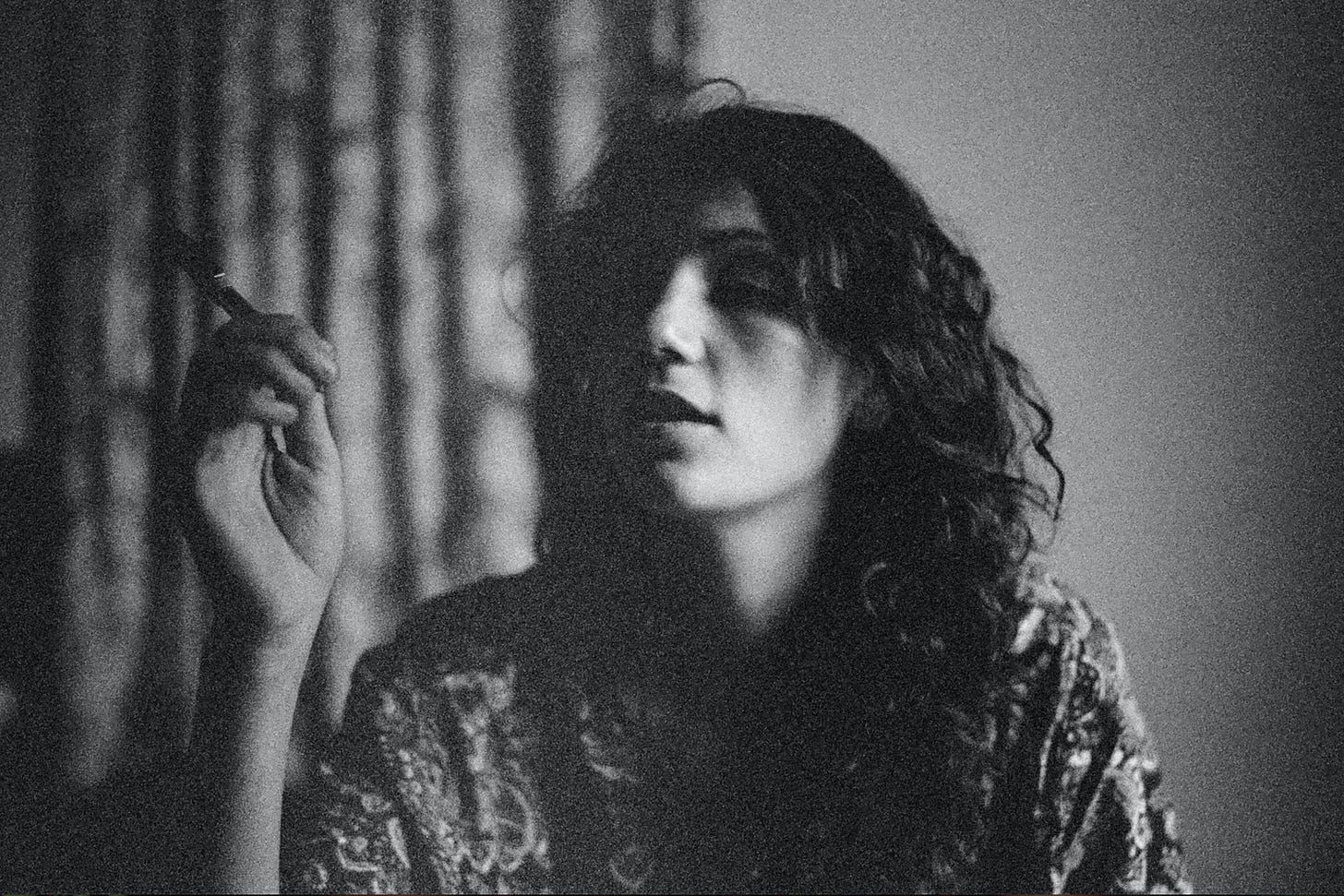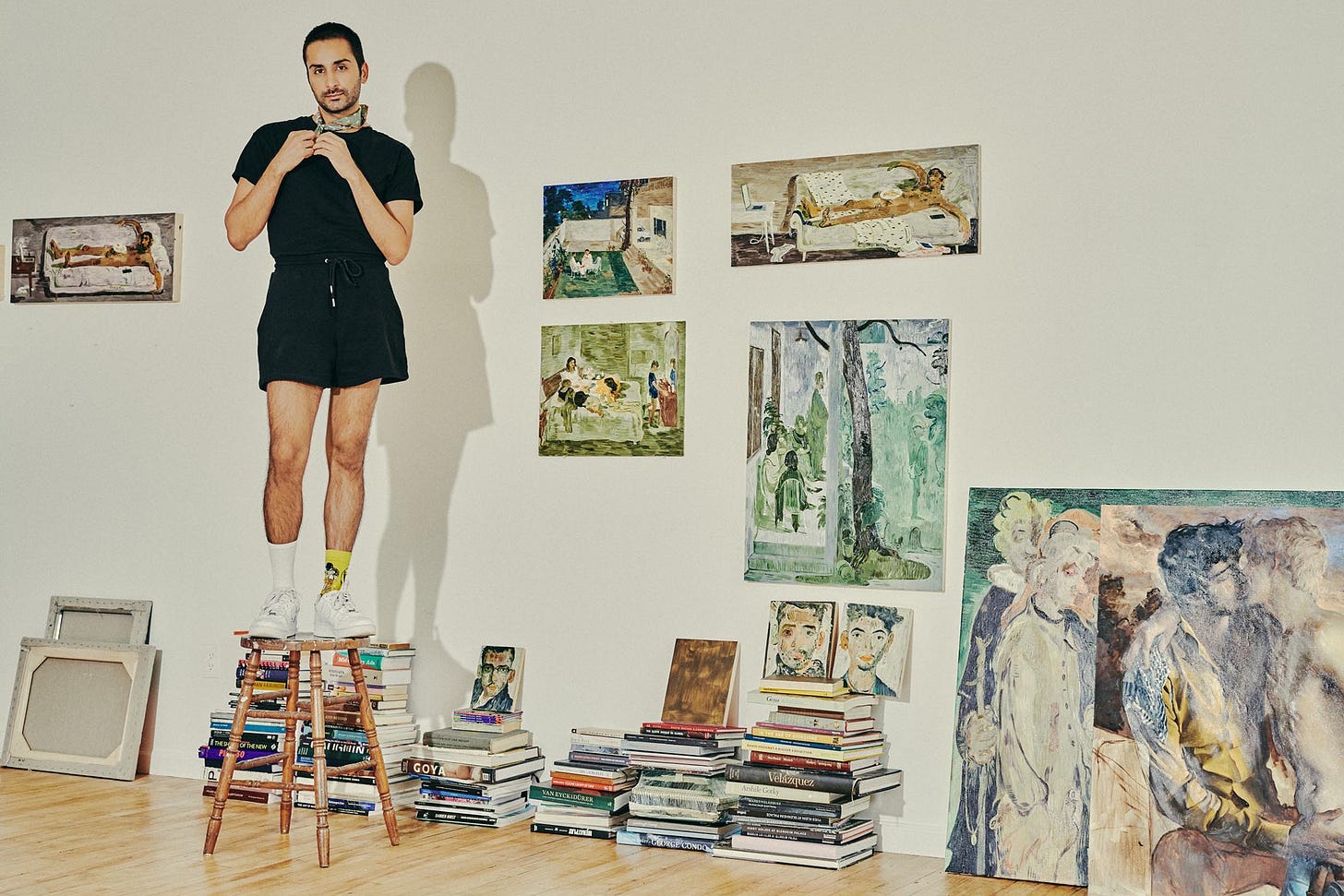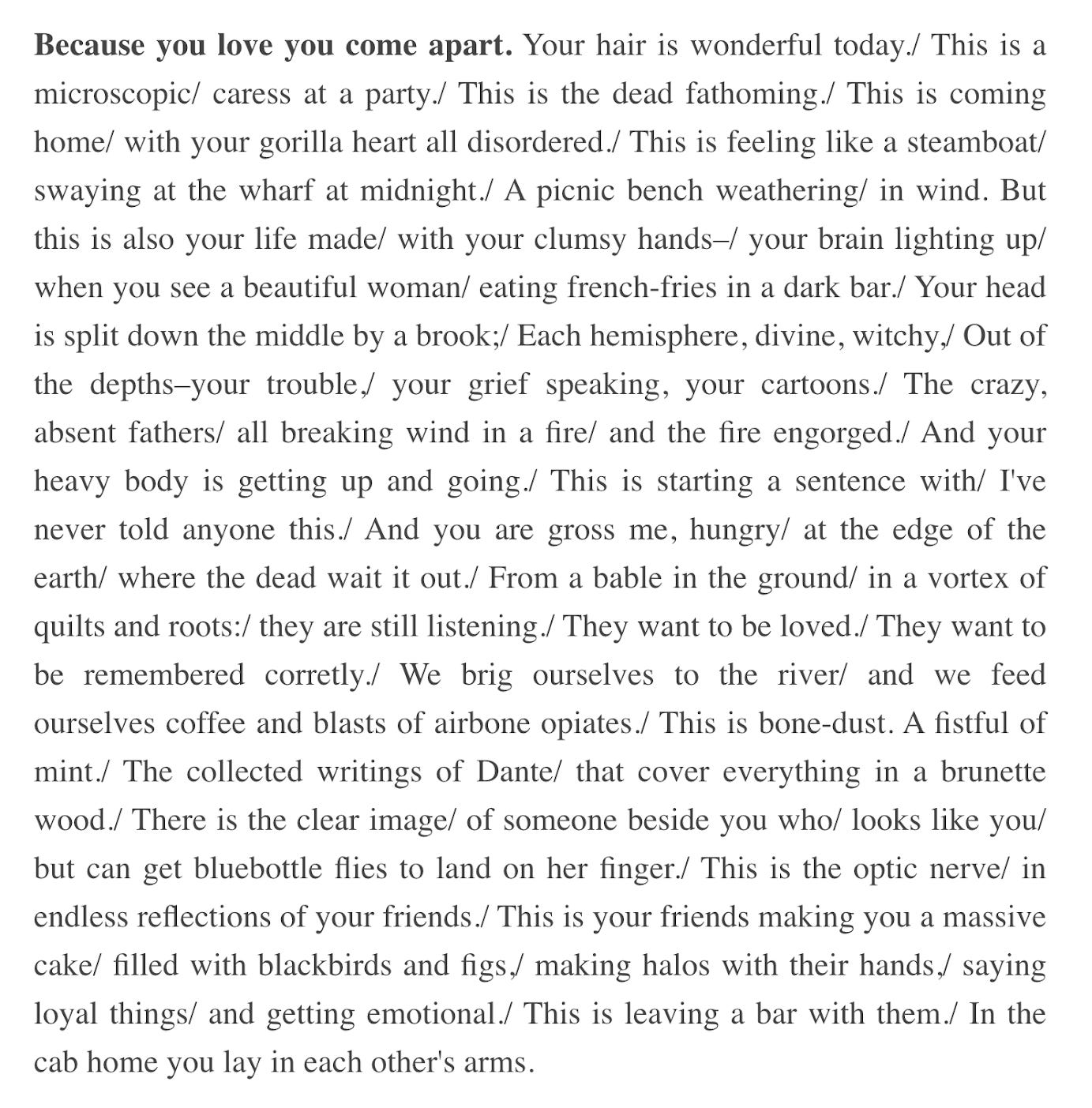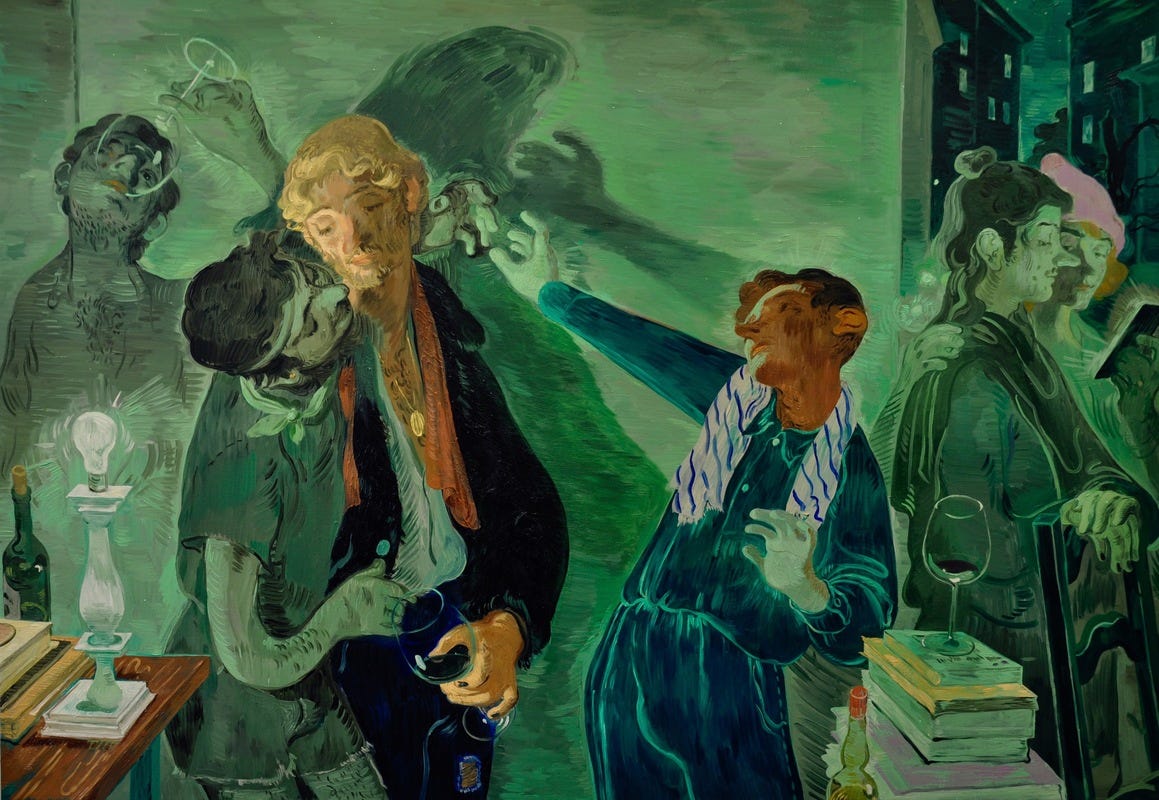On Salman Toor
Intertext Messenger with Emmi Greer
EMMI GREER (all pronouns) is a writer, editor, educator, and snack artist devoted to exploring the polyamorous relationships between language, art, and consciousness. They scribble poems, menus, and lots of snail mail in Portland, Oregon. They also curate and edit the local anthology publication Buckman Journal. She will probably see you at a reading soon.
SALMAN TOOR was born in Lahore, Pakistan, in 1983. He lives and works in New York City. Toor received an MFA in Painting from Pratt Institute in Brooklyn in 2009. His paintings are figurative, varying in scale and style, ranging in subject from art history to queer culture to Post-Colonialism. Toor has had several solo exhibitions in the US and Pakistan and has participated in significant group shows such as the Kochi Biennale 2016. His work is included in the permanent collection of Tate Modern and has been featured in publications such as ArtAsiaPacific, Hyperallergic, Artsy, Wall Street International, Gay Letter, Cultured, and Out Magazine.1
You, 4:03 PM
Testing, testing…
emmi greer, 4:03 PM
Transmission received
You, 4:04 PM
Fantastic
You, 4:05 PM
We're here to talk about Salman Toor and your poems(!)
I really just want to start by asking about your love of his work. When it started, how the affection grew or what sparked your love of his paintings...
emmi greer, 4:08 PM
I had seen Salman's work for a few years prior but only on screens. In 2023, I got to see his exhibition "No Ordinary Love" at HOMA (Honolulu Museum of Modern Art) and it was absolutely the best museum experience I've ever had. My friend and I were the only ones in the gallery at the time and so we got to hang out with all these sketches and paintings and I haven't stopped thinking about them since.
You, 4:12 PM
I'm picturing all of this green and quiet.
Toor mentions the nocturnal, glamorous elements of emerald green as part of his pull toward it. What does the green do to you?
Especially in a gallery setting, what did the green translate to in terms of the senses?
emmi greer, 4:18 PM
Yes, there were so many green paintings in the show! Researching more after I saw it, I've learned that what I take to be such a dreamy use of green in Toor's work is not without nightmare, but that day at the museum all I got was good feelings. It was so lush and exultant. Saturated and salvation-like.
I've heard that looking at multiple shades of green releases serotonin in human brains and I really felt that. I grew up in the desert and now live in the Pacific Northwest and I felt comforted and enveloped, held by the green. Satisfied.
You, 4:20 PM
That is delicious
And exemplifies one of your key traits which is that you know so many offhand tidbits—it's a joy to be around. It's probably a good time to announce that we work together, which is how I know this.
emmi greer, 4:22 PM
Ha thanks, I do love to be a know-it-all.
You, 4:23 PM
Ahaha ditto
So you wrote a series of poems in response to Toor's work titled Fag Puddles. I was fascinated learning about this element in his work—how he lumps objects together (hair, bodies, liquids...)
For example in Museum Boys here.
emmi greer, 4:29 PM
Totally. I adore the Fag Puddles. I feel like if my poems had forms, they would be puddles. It's about creating a space, a custom container, that doesn't exist elsewhere. The idea of piling up objects (images) very much reflects my composition style too.
It's like you said with the tidbits, like "look at all these things I've conjured, look at me with this assembly."
You, 4:32 PM
A big way I see you doing this is through the list or sequence and how the list materializes language as sound rather than definitional meaning.
This will be easiest to explain by sharing one of your poems:
FAG PUDDLE ON FRIDAY NIGHT
after Salman Toor by Emmi Greermeet at the best block to melt into
show up to the sedated forest
watch the tank-top prophet
in some dirtbag glamour
some nocturnal emerald—
licked in a rose bush
graceful and punctured
whole hands of sap
it all became a great rinse
a keened assembly
a gaggle of dykes
scooping the paw paw
rural-lithium-land-gulp
like lesbians shucking oysters
like death by digestion, by mythos
bound with seaweed ropes, partake
of the high high possession
you could use this green
strong on minerals, osmotic, glacier-fed
swirling the coupe—chartreuse, sativa, tanqueray
go over the ribs again and in between
want you to know mint, respite, crickets.
You, 4:33 PM
Like Toor’s paintings the poem rests on and brings our attention to objects and the senses they animate.
I guess I'm wondering now where this urge for accumulation comes from...
emmi greer, 4:35 PM
Well I guess now I'm wondering that too....
emmi greer 4:37 PM
The Fag Puddles literalize pastiche and I so relate to that. Lists can work similarly, simulating the speed of thought. I’ve always been a psychic collector with a strong long-term memory and that ongoing repository serves me well in many ways but is best as substrate for synthesis.
One of my favorite of Toor’s paintings, Three Friends in a Cab, naturally collides with the work of two other artists I love who reference, even glorify, the same setting: The song/music video “From the Back of a Cab” by Rostam Batmangilj, and the poem “Because You Love You Come Apart” by Bianca Stone.
I ritually read this poem to all my beloveds on their birthdays.
That this perfect painting, song, and poem came from three different consciousnessness and get to coalesce within mine, lets me know there may be something inherently “poetic” or universally meaningful about being in the backseat, a little melty, shoulder to shoulder with your dear people.
emmi greer, 4:40 PM
On a base level, tactile things give me a lot of enjoyment. But in relation to my poetics, I think of poetry, ideally, as a montage. Stories have their shape, but poems get to be shapeshifting and chock-full. So maybe something about abundance...
emmi greer, 4:43 PM
"Sensory medicine" is a phrase I could use to describe many of Toor's paintings. It’s also what I'm often reaching for with my writing.
You, 4:45 PM
Sensory medicine makes a lot of sense to me, especially with regard to sound.
From the first time I heard you read, I admired the way you made music in your poems using language as an instrument. When spoken out loud this has a very enchanting quality, kind of like standing in an emerald room of Toor’s paintings. I also appreciate your endings. How airy they are, how they float away. This causes me as a reader to stop and consider.
You, 4:46 PM
How do you access the sound material in your poems?
emmi greer, 4:48 PM
Well wannabe musician here so thank you, now I'm just gonna say that I play language, that's my instrument.
emmi greer, 4:51 PM
I always compose with a sound-first ethos. The syllables, and even more, how they sound together is what guides me
Super practically, I write six lines of poetry a day, then transcribe those lines on a monthly basis and that's my material for making complete poems.
I'm still searching for a title for my poetics if you have any suggestions! It took me years of being serious with poetry to find that style, which I see for Salman too. He was painting for years, emulating the European masters, but when he started queering it, that's when things really started popping off.
You, 5:00 PM
Absolutely, I feel like that turn aligned his work as a self-proclaimed "sissy boy" from Pakistan. And I'm really struck by how femininity is expressed, rather than argued for. How he harnesses domesticity with tenderness and jubilation.
You, 5:00 PM
(I'll think on your style and possible terminology—there's a similar glimmer and maximalism at play.)
emmi greer, 5:03 PM
Yes, he once described the green as a way to depict “a space of self; for enhancing the self.” That's gotta be some of what poetry's trying to do too.
You, 5:06 PM
Interesting. Maybe the green is a way to let the self slip too. A way of emphasizing the environment in order to allow the self to waltz through as it wants. Or at least... this is the freedom I find in writing poetry and in simply viewing the paintings
You, 5:08 PM
To end, I want to intertwine what's in your bio with the depiction of queerness in Toor's work.
You write that you want to explore the polyamorous relationship between language, art, and consciousness. What has Toor's work and your writing of Fag Puddles revealed to you about this dynamic (between language, art, and consciousness)?
emmi greer, 5:11 PM
Oh yeah! Sorting through many thoughts on this for a sec...
emmi greer, 5:18 PM
I am so appreciative of the presentation of queer subjects in all Toor's paintings, which I think radiate a great empathy, regardless of context. And that matters especially at a time when the pejorative of "fag" is turning over, still split on its threshold of reclamation.
emmi greer, 5:22 PM
They depict exactly the life that I, as a queer person raised in rurality, would always be imagining: very styled, very cosmopolitan, the various intimacies–a radically different adulthood. Especially because Salman's style of painting is so informed by art history, I can't help but feel like the scenes in the paintings are being elevated to renaissance, entering surreal and quotidian scenes of queer community and modernity into the canon. Living as an artist can sometimes feel like a bit of a ravine, in that you're inhabiting both the world you live in and the one you create, but a lot of his paintings seem to be able to live in the lovely overlap.
I look at a lot of the green paintings and think: that must be what queer paradise looks like.
The Green Room is one! Bar Boy is another!
Language and art are ultimately expressionistic of consciousness, but I'm still exploring those overlaps too. I know you can't really have any one without the others.
Support
To encourage more chats like this one, please consider a paid subscription:
To listen to this conversation with automated audio, download the Substack app:











